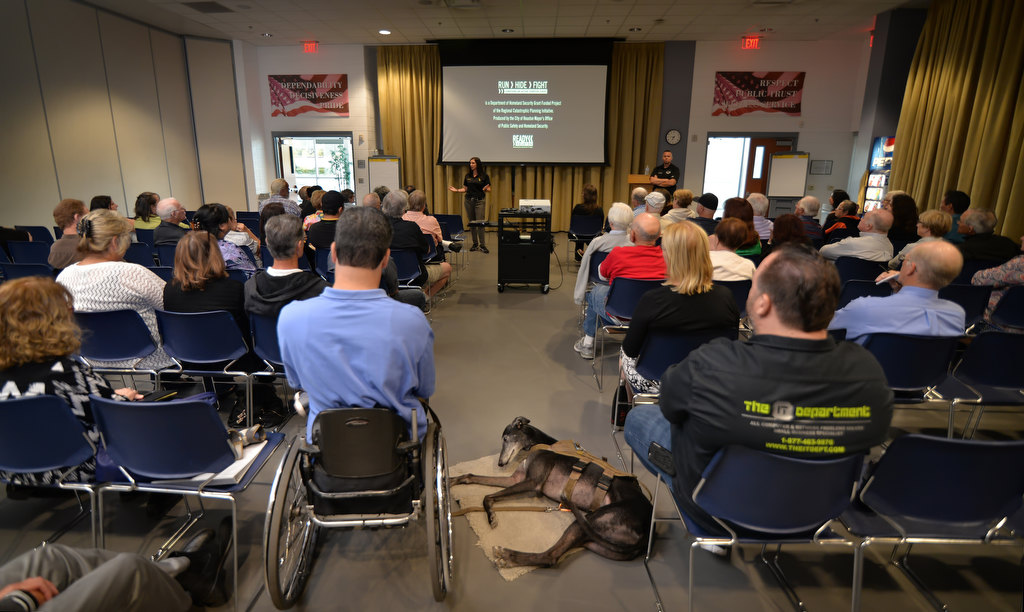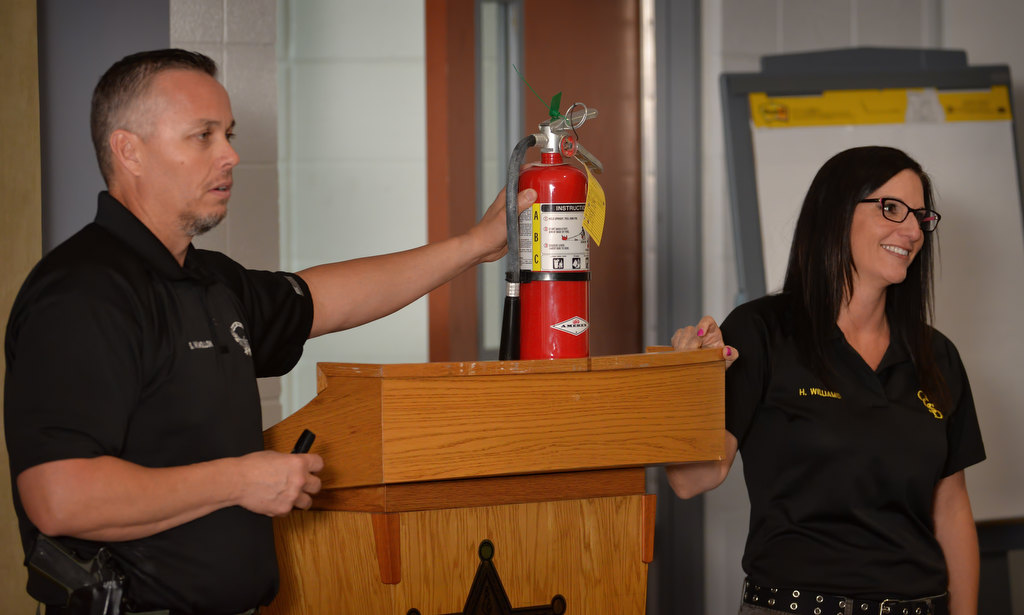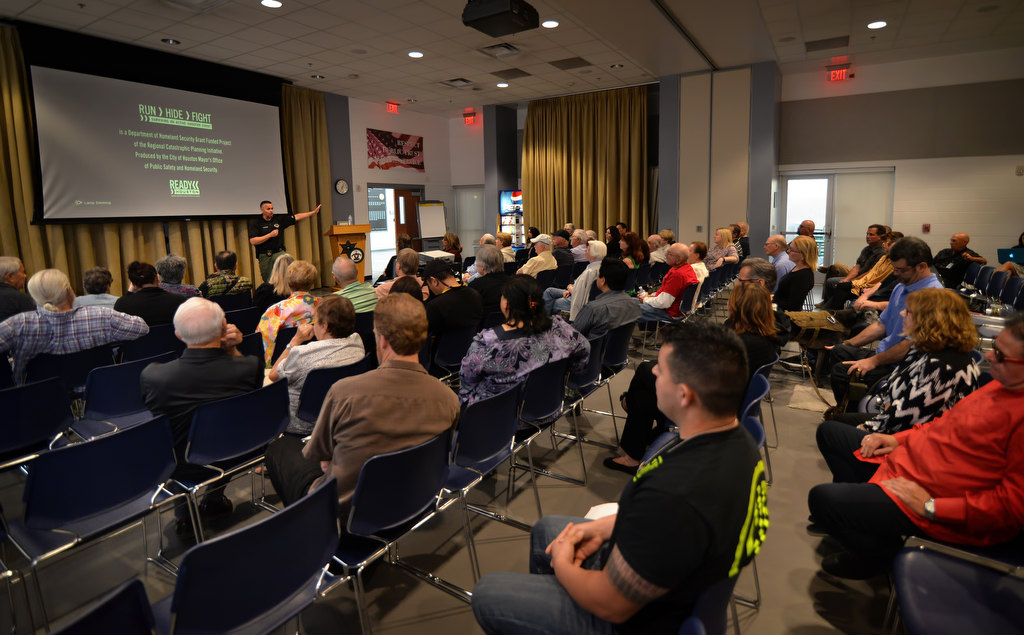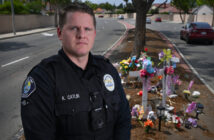When you walk into your office tomorrow morning, sit down. Then take a good look around. And ask yourself this question: What’s the quickest way to get out of here if a shooter walks in, or where will I hide if I can’t run?
Then ask yourself another question: If there’s nowhere to hide, what can I use to save myself?
Think outside the box now.
Your purse carrying the equivalent of a brick? Then swing it like a lasso.
You’re wearing a belt or shoelaces or using a laptop power cord? Use to tie doors shut, buy you some time.
Is there a fire extinguisher nearby? You can use that to whack someone over the head. Or spray them in the face.
Just don’t be timid.
There is a new thinking, an audience of 70 citizens was told at an Active Shooter Response and Workplace Violence presentation recently at the Orange County Sheriff’s training facility in Tustin:
Run. Hide. Fight.

Members of the public attend an educational talk at the OCSD Regional Training Academy in Tustin on what to do if you find yourself in an active shooter situation.
Photo by Steven Georges/Behind the Badge OC
Not all at once, of course.
Run, if you have the chance.
If that’s not possible, then hide.
If there’s nowhere to hide, you MUST fight. Pleading and begging probably isn’t going to save you.
From witness accounts at past mass shootings, we know that the guy with the gun is in no mood to reason. You can’t rationalize with someone in a shooting frenzy.
“If you are laying on the ground or under a desk, please don’t play dead,” said Heather Williams, Regional Peer Support Coordinator for the OCSD. “And don’t put your hands up and say, ‘Please don’t shoot me, I’m a mother.’ Is that person reasonable? Should we be reasoning with them? Absolutely not.”
The owner of Salon Meritage in Seal Beach tried to reason with Scott Dekraai when the gunman walked in looking for his wife in 2011; asking him to please go outside with him and talk things out. Dekraai shot him dead, along with seven others in 2 minutes flat.
“It changed my life,” said Williams, who spent the next 30 days working with the survivors of that rampage as the Crisis Response Team Coordinator for the non-profit Community Service Programs.
She was also on the scene at the Albertsons in Irvine days after a bagger with a sword killed two and slashed three more.
If someone like that shows up at your work, and you are lucky enough to get to a room with a door, lock it, then barricade it with anything heavy in the room, douse the lights, silence your phone and stay quiet.
“Historically, active shooters will take the path of least resistance,” says Shane Millhollon, an OCSD Swat Team leader who led the presentation with Williams. “If a door is locked they go until they find an open door.”

Orange County Deputy Sheriff Shane Millhollon and Heather Williams, regional peer support coordinator at the Orange County Sheriffs Department, talk about what do to if you find yourself in an active shooter situation and what to look for in a room if you, as a last resort, have to defend yourself.
Photo by Steven Georges/Behind the Badge OC
Together, Millhollon and Willliams have held 78 Active Shooter presentations since 2013. The county began requiring presentations for all employees after the terrorist shooting in San Bernardino in December.
One of their messages is that people need to understand that there’s a range of reactions in an active shooter scenario.
“We’re going to have some folks freeze up, we’re going to have folks who start praying, we’re going to have folks who take charge,” says Millhollon. “Some go weak in the knees, others get strong with adrenaline.”
Just don’t panic, and, since bullets can go right through walls, stay low.
“So here we are laying on the floor and now he’s coming through the door,” Millhollon told the crowd. “We’re going to get up and fight for our lives. What’s organic to you that you can use as a weapon?”
Audience members shouted out answers.
A Coke bottle on the desk. A chair. The clock on the wall or a thermos can be a weapon if they’re heavy enough. A pen can poke an eye out. Keys. Nail files. Hot coffee in the face.
“We’re fighting for our life, please understand,” Millhollon said. “So sit at your desk tomorrow and start looking at all the impromptu weapons you have. Please take the time to start preparing yourself. This is where the empowerment comes in.”
FBI statistics show that between 2000 and 2013, 486 people were killed and 557 injured in 160 shootouts nationwide. More than 60 percent of the shootouts were over before police arrived, so it often is up to you to save yourself.
If you manage to knock the shooter to the ground, “let’s end this right now,” Millhollon says. “Make sure he doesn’t get up and chase you.”
At the same time, he cautioned, don’t take the weapon and shoot the shooter. If an officer is walking in they might think you’re the killer.
If police arrive: hands up, fingers spread, and don’t hold your cell phone, which can be mistaken for a weapon.
“Let the police know, ‘I’m a good guy,’” Millhollon says.
Williams also encouraged the audience to report something if they think it is suspicious since this has in the past thwarted a killer’s plot.
“We have people say they don’t want to profile,” she said. “Here’s what I’m going to say to that: You are not reporting the person. You are reporting the behavior.”
If you hear someone say something at the office that can be construed as a threat, or if a co-worker changes their behavior, withdraws, acts unusual, say something.
“Don’t be the employee police with a whistle around your neck blowing it on everyone because they’re having a bad day,” Williams said. “But listen to your gut. We’ve all been in this situation and we’ve ignored it. Start paying attention.”
And talk to your kids, “not to scare them,” she said, but so they have a plan when you’re not with them.
“Unfortunately, we can’t predict when this will happen,” said Millhollon. “We have to be prepared for when it does.”
If an agency/organization is interested in scheduling a presentation, contact Williams at hwilliams@ocsd.org
 Behind the Badge
Behind the Badge




